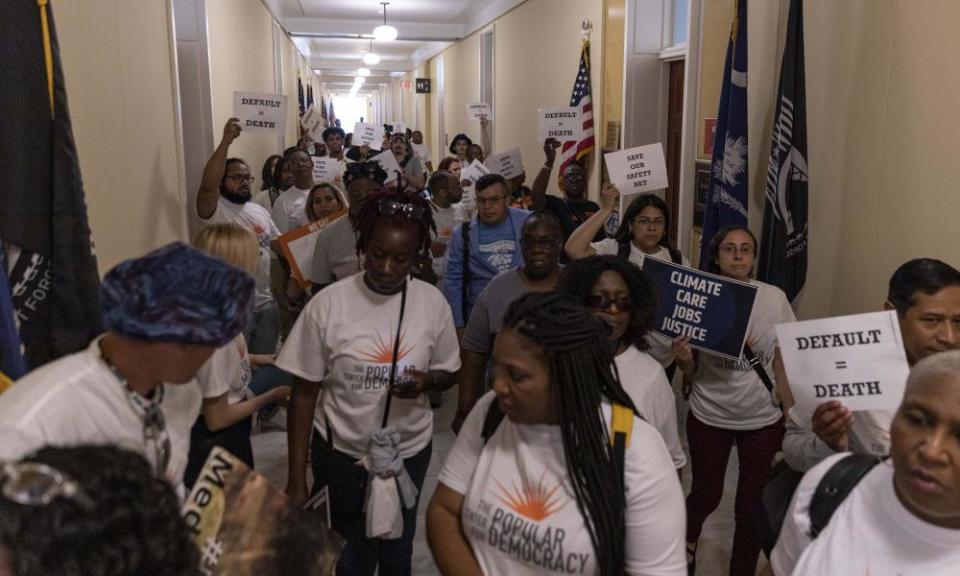What is the US debt ceiling and what would happen if it is not raised?

Joe Biden and the House Republican speaker, Kevin McCarthy, have reached a deal “in principle” to raise the federal government’s $31.4tn debt ceiling, potentially averting an economically destabilising default on 5 June.
With any new agreement still required to pass through a divided Congress, the risk that the Treasury department runs short of money to cover all its obligations does however remain.
Without raising the debt limit, the US government would default on its bills, a historic first that would likely carry catastrophic consequences. Federal workers would be furloughed, global stock markets would crash and the US economy would probably drop into a recession.
Related: Danger and deja vu: what 2011 can tell us about the US debt ceiling crisis
As details of the deal begin to come to light, here is a quick guide on the debt ceiling and what it means for the US government and people across the country:
What is the debt ceiling?
The debt ceiling is the limit on the amount of money the US government can borrow to pay for services, such as social security, Medicare and the military.
Each year, the government takes in revenue from taxes and other streams, such as customs duties, but ultimately spends more than it takes in. This leaves the government with a deficit, which has ranged from $400bn to $3tn each year over the last decade. The deficit left at the end of the year ultimately gets tacked on to the country’s total debt.
To borrow money, the US treasury issues securities, like US government bonds, that it will eventually pay back with interest. Once the US government hits its debt limit, the treasury cannot issue more securities, essentially stopping a key flow of money into the federal government.
Congress is in charge of setting the debt limit, which currently stands at $31.4tn. The debt ceiling has been raised 78 times since 1960, under both Democrat and Republican presidents. At times, the ceiling was briefly suspended and then reinstated at a higher limit, essentially a retroactive raising of the debt ceiling.
What happens if the US defaults?
The US has never defaulted on its payments before, so exactly what would happen is unclear. It’s not likely to be good.
“Failure to meet the government’s obligation would cause irreparable harm to the US economy, the livelihoods of all Americans and global financial stability,” the US treasury secretary, Janet Yellen, said in a letter to Congress in January.
Investors would lose faith in the US dollar, causing the economy to weaken quickly. Job cuts would be imminent, and the US federal government would not have the means to continue all its services. Mortgage rates would probably soar – tanking the housing market.
Why is the US debt so high?
The US debt grows when the government is spending more money or when its revenue is lower.
Throughout its history, the US has had at least some amount of debt. But the debt really started to grow in the 80s, after Ronald Reagan’s huge tax cuts. Without as much tax revenue, the government needed to borrow more money to spend.
During the 90s, the end of the cold war allowed the government to cut back on defense spending, and a booming economy led to higher tax revenues. But then, in the early 2000s, the dotcom bubble burst, leading to a recession. George W Bush cut taxes twice, in 2001 and 2003, and then the US military campaigns in Iraq and Afghanistan increased spending by as much as nearly $6tn over the course of the war.
When the 2008 Great Recession started, the government had to bulk up spending to bail out banks and increase social services as the unemployment rate hit 10%.
When the unemployment rate returned to its pre-recession levels, in 2017, a major tax cut was passed under Donald Trump. The debt rose by $7.8tn while he was in office.
And then the Covid-19 pandemic hit. The US government passed a series of stimulus bills to offset the worst of the pandemic’s impacts that ultimately totaled $5tn.
What are the main contributors to federal government spending?
The biggest chunk of US government spending goes to mandatory programs, such as social security, Medicaid and Medicare, which comprise nearly half of the overall annual budget. Military spending takes up the biggest chunk of discretionary spending, taking up 12% of the budget. Other big-ticket items include spending on education, employment training and services and benefits for US veterans.

 Yahoo Finance
Yahoo Finance 